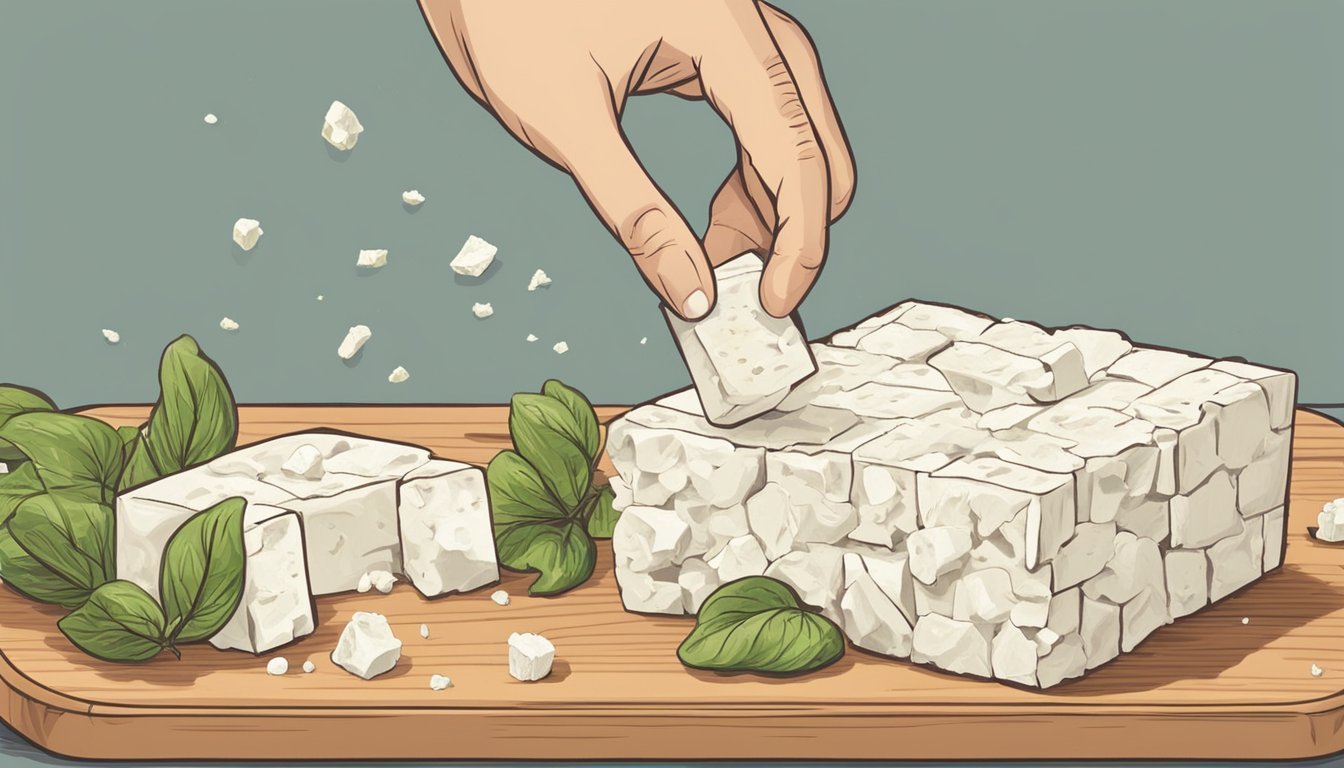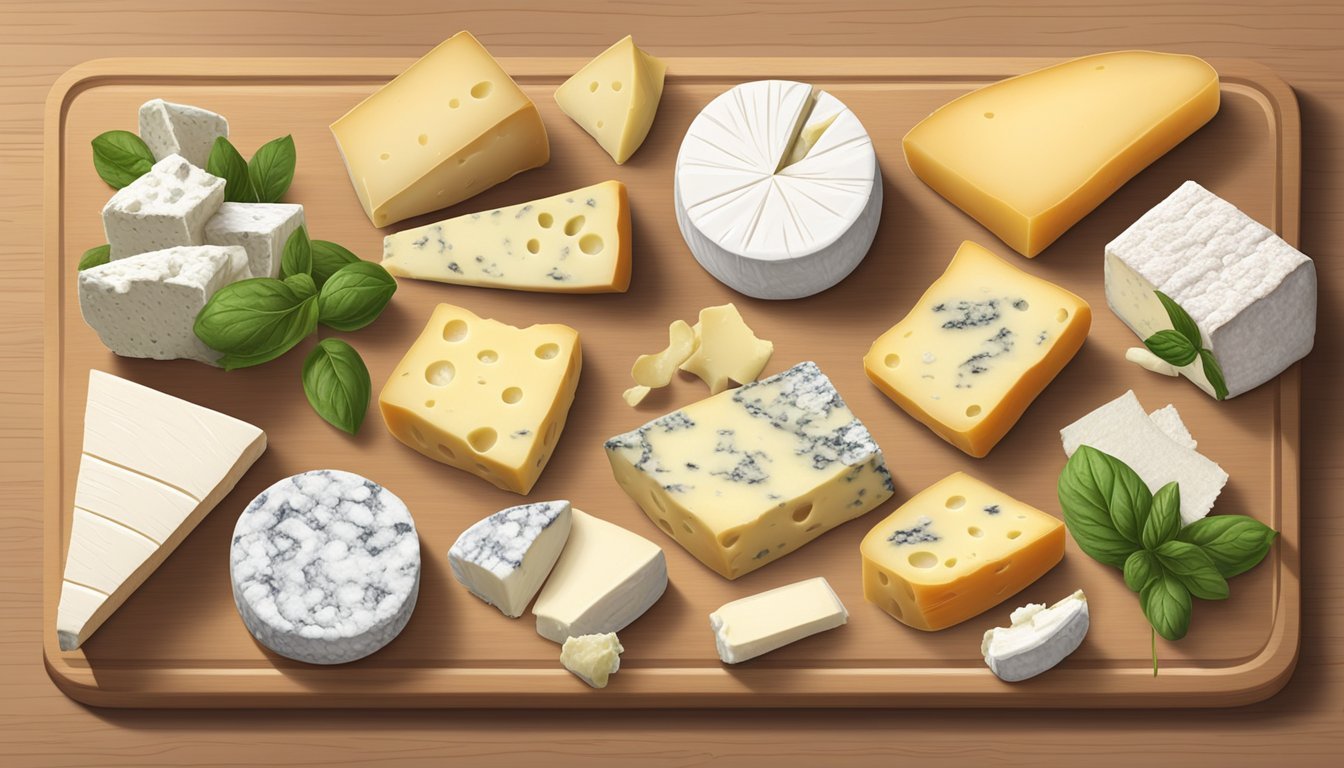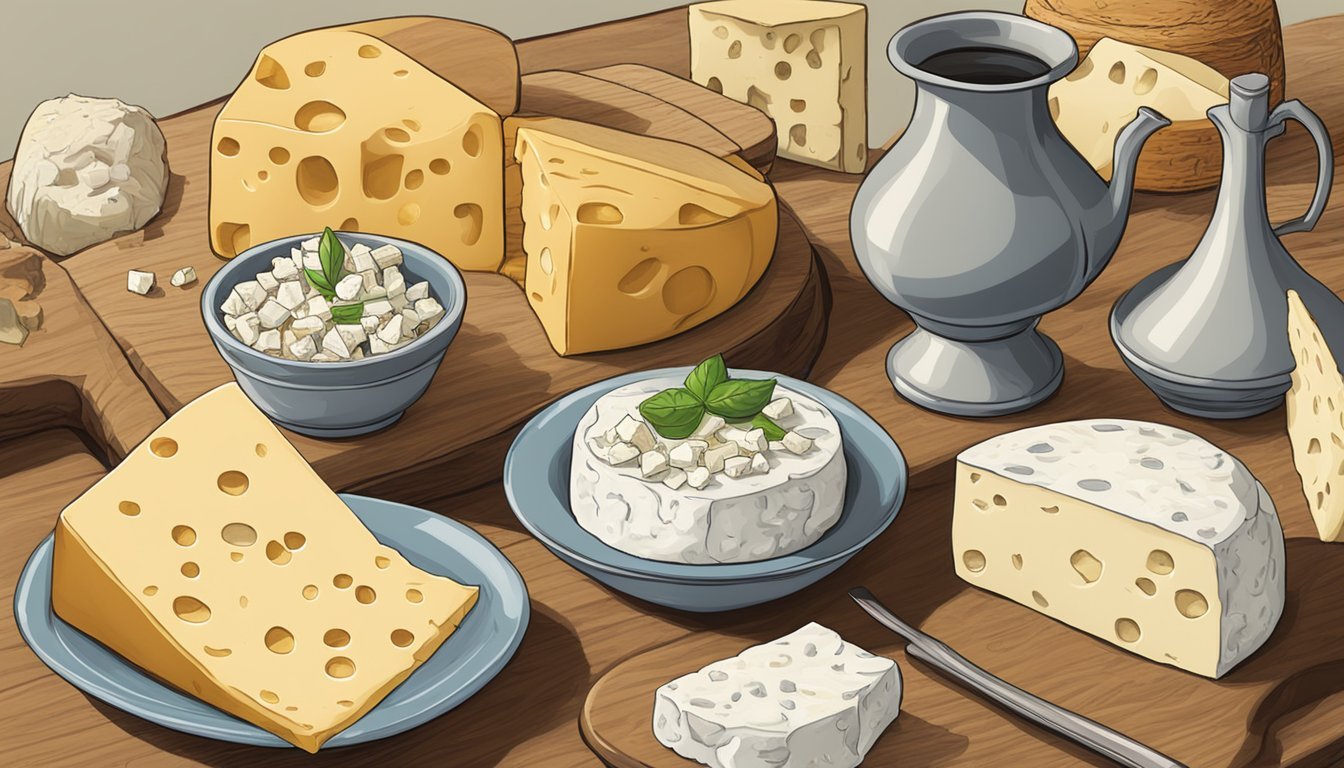How to Substitute Feta Cheese for Goat Cheese
A Simple Guide
Substituting feta cheese (how long does cheese last?) for goat cheese is a common practice in the kitchen, offering cooks the ability to adapt recipes according to availability, dietary preferences, or simply to experiment with different flavors. Feta and goat cheese (What wine goes well with cheese?) are distinguished dairy products, each bringing its own unique taste and texture to dishes. While feta, a brined curd white cheese made traditionally from sheep's milk or a mixture of sheep and goat's milk, usually presents a tangy and salty flavor with a crumbly texture, goat cheese, produced solely from goat's milk, offers a creamier consistency and a milder tang.
When one considers incorporating feta as a substitute for goat cheese, they should be mindful of the differences that may affect the final outcome of their culinary creation. Feta's pronounced saltiness and firmer texture can alter the intended flavor balance and mouthfeel of recipes that typically call for the smoother, subtler notes of goat cheese. Adjustments in seasoning or preparation methods may be necessary to achieve a harmonious dish. It is important for the cook to recognize that while the substitution can work well across a variety of recipes, the presence of feta will inherently steer the dish towards a more Mediterranean profile, a characteristic hallmark of this cheese.
Moreover, chefs and home cooks alike should consider the context of the dish when deciding on this substitution. Whether the cheese serves as a primary ingredient, as in a salad or a tart, or more of a garnish, will largely dictate the suitability of feta in place of goat cheese. In cooked applications, such as baking or grilling, the distinctive textural properties of feta will render a slightly different but still pleasing result, provided that expectations are adjusted for the switch in cheese type. Therefore, while feta can successfully stand in for goat cheese in many situations, one should do so with an understanding of the sensory shifts that will inevitably occur.
Understanding Cheese Fundamentals
When substituting feta cheese for goat cheese, it is essential to comprehend the complexities surrounding cheese types and the intricacies of cheese production and aging, as these factors influence texture and flavor profiles.
Types of Cheese
Cheeses are categorized based on factors such as the type of milk used, texture, and flavor. Traditional categorizations include:
Fresh cheeses (What wine goes well with fresh cheeses?): These cheeses, like goat cheese, have high moisture content, don't undergo an aging process, and have a mild flavor. Examples include ricotta and cream cheese (how long does cream cheese last?).
Aged cheeses: These are matured over time, which intensifies their flavor and alters their texture. Feta falls into this group, with a crumbly texture and tangy taste.
Soft cheeses (What wine goes well with soft cheeses?): These cheeses are typically creamy, like camembert, and have a rich flavor profile.
Semi-soft cheeses: This category includes cheeses like havarti which are firmer than soft cheeses but still pliable.
Hard cheeses: With low moisture content, these cheeses, such as parmesan, are aged longer and have a strong flavor.
The cheese's nutritional content, including protein, fat, calcium, and calories, also varies with its type.
Cheese Production and Aging Process
Cheese production starts with coagulating milk, followed by curd processing and aging:
Coagulation: The milk is curdled using rennet or acidic substances, initiating cheese formation.
Curd Treatment: Curds may be cut, cooked, and washed, which affect cheese texture and moisture.
Aging: The period during which a cheese matures is critical to flavor development. The length of this process can range from weeks (fresh cheese) to several years (aged cheese), impacting the concentration of flavor.
Feta: Typically ages for two to three months, acquiring its signature salty tang.
Goat Cheese: Fresh varieties have little to no aging, making them more delicate.
Each step of the production process determines the final product's qualities, including age, flavor, texture, and nutritional components such as protein, fat, calcium, and calories.
Exploring Feta Cheese
Feta cheese is a staple in Greek cuisine known for its crumbly texture and tangy flavor. It is both nutritious and versatile in culinary applications.
Characteristics of Feta
Feta cheese, traditionally hailing from Greece, takes pride in its unique sensory characteristics. It exhibits a creamy texture while maintaining a crumbly structure that is easily identifiable amongst cheese varieties. Its tangy flavor has a slight saltiness, which works harmoniously with a variety of dishes without overpowering them. Authentic feta is made primarily from sheep's milk and sometimes mixed with goat's milk, contributing to its distinct taste.
Nutritional Profile of Feta
The nutritional value of feta cheese can be summarized in a brief table:
Nutrient Amount per 100g Calories 264 Protein 14g Fat 21g Carbohydrates 4g Sodium 1,116mg
Feta is a source of calcium and phosphorus, essential for bone health. Despite its nutritional benefits, its high sodium content warrants moderation for those monitoring their salt intake.
Culinary Uses of Feta
Feta's culinary versatility allows it to be employed in a multitude of dishes. It's a key ingredient in a traditional Greek salad, providing a flavorful complement to the fresh vegetables. Feta pasta dishes benefit from the cheese's ability to add a creamy consistency without overwhelming other flavors. Additionally, feta can be incorporated into omelets, sandwiches, and baked goods, demonstrating its adaptability in various recipes beyond the Greek cuisine spectrum.
Delving Into Goat Cheese
Goat cheese, known for its distinct tangy taste and creamy texture, comes in various forms and is versatile in cooking. Its profile, varieties, and culinary uses are diverse.
Profile of Goat Cheese
Goat cheese is traditionally made from goat's milk and exhibits a refreshing tanginess that can range from mild to sharp. It's prized for its creamy and sometimes semi-soft consistency. Fresh goat cheese tends to have a softer texture and a more delicate flavor compared to aged varieties, which can develop a firmer consistency and a more robust taste.
Goat Cheese Varieties
There are numerous types of goat cheese, each with unique characteristics:
Fresh Goat Cheese: Soft and spreadable, with a bright, acidic flavor.
Aged Goat Cheese: Develops a firmer texture over time and can take on earthy flavors.
Flavored Goat Cheese: Often incorporates herbs, spices, or edible flowers for added taste.
Goat Cheese in Cooking
Goat cheese is quite versatile in the kitchen. It can be crumbled over salads for a zesty addition, spread on crackers or bread, or melted into warm dishes, enhancing them with its distinct flavor. It's a key component in many recipes that call for a cheese with presence but not overpowering dominance.
Comparing Feta and Goat Cheese
When substituting feta cheese for goat cheese, it's important to consider their taste and texture differences, nutritional profiles, and how they perform in recipes to maintain the integrity of your dish.
Taste and Texture Differences
Feta typically has a tangy, sharp taste with a crumbly and creamy texture. It is well-known for its salty flavor.
Goat Cheese is known for its smooth, creamy texture and has a mild, often tangy flavor that can be earthy or sweet, depending on the process.
Nutritional Differences
Feta Cheese is higher in sodium and lactose, while Goat Cheese possesses a similar calorie count but can have less lactose content which is beneficial for those who are lactose intolerant. Both cheeses offer a good source of protein and calcium.
Nutritional Yeast: Not applicable in the direct comparison but worth mentioning as a cheese alternative that offers additional nutritional benefits like B-vitamins.
Recipe Suitability
In recipes, feta and goat cheese can often be used interchangeably; however, the saltiness and firmness of feta may affect the final product.
Goat Cheese Substitutes: Ricotta can serve as a low-fat alternative, although it has a milder flavor and looser texture.
Feta Cheese Substitutes: For a similar texture, one might consider crumbled options like tofu or for a tangy taste, a thick, creamy labneh.
Substituting Feta for Goat Cheese
When substituting feta for goat cheese, a cook must consider both the consistency and flavor profile differences to achieve a similar result.
How to Choose a Substitute
One must choose a feta that closely matches the goat cheese's crumbly yet creamy texture. While no substitute is perfect, feta is a particularly suitable option due to its similar crumbly consistency. To mimic the creaminess of goat cheese, they can opt for a feta that has a higher fat content. The flavor of feta is tangier and saltier than goat cheese, so selecting a milder feta can be preferable for those seeking to closely replicate the original recipe's taste profile.
Consistency: Crumbly, like goat cheese.
Flavor Profile: Choose a milder feta to not overpower the dish.
Adjusting Recipes for Feta
Recipes that call for goat cheese might need slight adjustments when using feta. The key changes revolve around the salt content and the moisture level of the feta cheese compared to goat cheese.
Reducing Salt: As feta is saltier, there might be a need to decrease the additional salt used in the recipe.
Moisture Differences: If a recipe requires the creamy aspect of goat cheese, it may be necessary to blend feta with a bit of cream or yogurt to achieve a similar moisture content.
By considering these factors, the chef can successfully substitute feta in place of goat cheese maintaining the integrity of the dish.
Alternative Cheese Options
When seeking to substitute feta cheese with goat cheese, it's crucial to consider the textural and flavor profiles of potential replacements. Below are specifics on cheese characteristics and non-dairy alternatives that can be used effectively in various dishes.
Cheese Substitute Characteristics
Ricotta: With a smooth, creamy texture, ricotta cheese is an excellent choice for dishes that require a milder flavor. It melds well in pasta dishes and can be a good addition to pizza toppings (What wine goes well with pizza toppings?) when looking for a less tangy cheese option.
Cream Cheese: Known for its rich and spreadable texture, cream cheese can serve as a substitute in recipes calling for goat cheese. Its mild taste allows it to blend seamlessly, making it a suitable replacement in recipes where goat cheese's robust flavor isn't essential.
Cottage Cheese (how long does cottage cheese last?): A softer cheese with a creamy and slightly lumpy texture, cottage cheese serves as an adequate stand-in, particularly when blended smooth for dips or spreads.
Cotija Cheese: While drier and more crumbly, Cotija cheese brings a saltiness similar to feta that can enhance savory dishes like tacos or enchiladas.
Cheddar: Sharp and more pronounced in flavor, cheddar is an alternative that should be used sparingly as it can significantly alter the taste profile of a dish.
Blue Cheese/Gorgonzola: These cheeses offer a pungent, bold flavor and crumbly texture, making them suitable for individuals who enjoy a cheese with a strong presence in salads or as garnishes.
Non-Dairy Alternatives
Tofu: Tofu can mimic the crumbly texture of feta, and when seasoned appropriately, can serve as a non-dairy substitute with success in salads and wraps.
Nutritional Yeast (Not mentioned in Entities): For a cheese-like flavor without dairy, nutritional yeast can be sprinkled over dishes, although it doesn't provide the same texture as feta or goat cheese.
Enhancing Recipes with Feta
Feta cheese is esteemed for its creamy texture and tangy flavor, making it a versatile addition to various recipes from refreshing salads to hearty main dishes and delicate pastries.
Salads
Feta lends a salty and tangy punch to salads, complementing greens and dressings with its crumbly texture. She can toss cubes or crumbles of feta into a Greek salad to amplify its Mediterranean flair, or sprinkle it over a watermelon and mint salad for a refreshing summer dish.
Greek Salad: Tomatoes, cucumbers, olives, red onions, and feta cheese.
Watermelon Salad: Watermelon, mint leaves, and feta with a drizzle of balsamic glaze.
Main Dishes
In main courses, feta proves its adaptability by enhancing not only the flavors but also adding a creamy mouthfeel. They can incorporate it into savory dishes like spanakopita or use it to stuff grilled chicken breasts (What wine goes well with chicken breast?).
Spanakopita: Spinach and feta filling wrapped in phyllo pastry.
Stuffed Chicken: Chicken breasts stuffed with feta, spinach, and sundried tomatoes.
Pastries and Appetizers
Its creamy yet crumbly texture makes feta an excellent filling for pastries and appetizers. They could feature feta in a variety of savory pastries, or melt it atop toast with a drizzle of honey for a simple yet elegant appetizer.
Savory Pastries: Feta-filled phyllo triangles or puff pastry tartlets.
Feta on Toast: Toasted bread topped with feta, herbs, and a honey drizzle.
In each of these uses, feta cheese adds depth and excitement to the dishes, proving that its tangy taste can transform the ordinary into the extraordinary.
Health Considerations When Choosing Cheeses
When substituting feta cheese for goat cheese, it is important to consider lactose content and its digestibility, as well as the fat content and overall nutritional impact of each cheese.
Lactose Content and Digestibility
Feta cheese and goat cheese are both suitable for individuals with lower lactose tolerance, as these cheeses have less lactose compared to other dairy products. However, since goat cheese is often fresher and less processed, it may contain slightly more lactose than feta cheese, although this may vary depending on specific processing practices.
Lactose Intolerance Consideration: Individuals who are lactose intolerant should verify the lactose level of the specific cheese brand they are considering.
Fat Content and Nutritional Impact
Both cheeses provide nutritional benefits, including protein and calcium; however, their fat profiles differ. Goat cheese typically has higher total and saturated fat content per ounce than feta cheese.
Fat Content:
Feta Cheese: 6 grams total fat (3.8 grams saturated)
Goat Cheese: 8.5 grams total fat (5.9 grams saturated)
These values suggest that selecting feta might be preferable for those watching their saturated fat intake. Despite the higher fat content in goat cheese, it contains beneficial fats that can contribute to one's daily intake in moderation.
Calories and Nutrition:
Generally, feta cheese is lower in calories than goat cheese.
Both cheeses offer essential nutrients like protein and calcium.
Remember, how these cheeses fit into one’s diet varies based on individual health goals and dietary needs. Some individuals may benefit from the probiotics present in both cheeses, which can support digestive health. It is always best to consume any cheese in moderation as part of a balanced diet.
Shopping and Storage Tips
When selecting feta as a substitute for goat cheese at the grocery store, shoppers should focus on the cheese's origin, texture, and rind. Proper storage is critical to maintain the cheese's flavor and extend its shelf life.
Selecting the Right Cheese at the Store
Feta cheese comes in various forms, and the type one chooses can affect both flavor and suitability as a substitute for goat cheese. European feta, especially Greek feta, is renowned for its quality. Look for feta with a creamy, yet crumbly texture, as it closely mimics the consistency of goat cheese. Ideally, the feta should have a white color and a tangy taste. Pay attention to the rind, as the presence or absence can affect the flavor and texture.
Proper Cheese Storage
The shelf life of feta cheese is significantly extended when stored properly. To maintain its freshness and flavor profile, store feta in the brine it comes in until ready to use. If the packaging does not include brine, one can submerge the feta in a solution of saltwater. For long-term storage, one might place chunks of feta in glass jars, leaving half an inch at the top, and cover completely with olive oil. Seal the jars tightly and store them in a cool, dry place. In the fridge, keep the cheese in an airtight container to prevent it from drying out. Freezing is an option but might alter the texture; thawed feta works best when crumbled in dishes.
Cultural Significance of Cheese
Cheese plays a pivotal role in global culinary traditions and has a rich history that spans across various cultures. Each region has developed its own unique types of cheese, contributing to the cultural identity of their cuisines.
Cheese in Different Cuisines
Greek: Greek cuisine is known for its feta cheese, a brined curd white cheese made from sheep's milk or a mixture of sheep and goat's milk. It's integral to dishes such as Greek salad, spanakopita, and tyropita.
Middle East: In the Middle East, cheeses like Halloumi and Labneh hold cultural significance. Halloumi, often made from a mixture of goat's and sheep's milk, is enjoyed grilled, while Labneh, a strained yogurt cheese, is a staple in mezze platters.
French Cheese: France's diverse range of cheeses, such as Brie, Camembert, and Roquefort, is a testament to its storied cheese-making tradition. Each region in France boasts its own specialty cheese that reflects the local culture and terroir.
Mexican Cheese: Mexican cheese varieties, including Queso Fresco, are a fundamental component of Mexican cuisine. Queso Fresco, a fresh cheese made from cow's milk or a mixture of cow and goat's milk, is commonly crumbled over tacos, enchiladas, and salads.
Historical Perspective on Cheese
Europe: Cheese has been a part of European diets for thousands of years, with evidence of cheese-making dating back to 5500 B.C. Its iteration and refinement over centuries have led to the vast assortment of cheeses known today.
French Cheese: Historical records suggest that many French cheeses have medieval origins, and their production methods have been passed down through generations, playing a key role in the cultural and gastronomic heritage of each region.
Greek: The history of feta cheese traces back to Ancient Greece, where it was mentioned in Homer's Odyssey. Feta cheese's cultural importance is reflected in its Protected Designation of Origin (PDO) status within the European Union, meaning it can only be called 'feta' if produced in certain areas of Greece using traditional methods.
By examining the cultural significance of cheese in cuisines and its historical perspectives, one can appreciate the diversity and importance of cheese in culinary traditions worldwide.
Conclusion
Substituting feta cheese for goat cheese is a practical and often delicious choice in various recipes. The firmer texture and tangy flavor of feta can mimic the distinctive characteristics of goat cheese well. Individuals seeking variety in their dishes will find that feta cheese provides a slightly different taste profile while still maintaining the essence of the dish.
Practical Tips for Substitutes:
Ensure the feta cheese is crumbled to match goat cheese's texture.
In cooked recipes, feta's firmer texture should be considered, as it may not melt as smoothly.
Balance the salt content since feta can be saltier than some goat cheeses (What wine goes well with goat cheeses?).
Recipe Adaptation:
Salads: Feta can be directly swapped in for goat cheese.
Baked dishes: Use feta sparingly to avoid overpowering the dish.
Sauces and dressings: Balance out the extra tang of feta with cream or mild yogurt.
Chefs should note that while feta is a reliable substitute, it cannot replicate the exact flavor of goat cheese. Every cheese has its unique properties, thus small adjustments may enhance the compatibility of feta in recipes originally calling for goat cheese.
In summary, culinary enthusiasts can confidently use feta as an alternative to goat cheese, knowing it will contribute a desirable texture and flavor to their dishes, with some attention to the differences. This substitution allows for flexibility and creativity in the kitchen, catering to diverse palates and dietary preferences.











